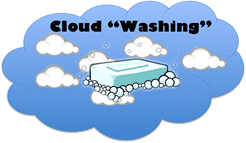I have multiple personalities. No, I’m not schizophrenic but I do have alter egos. During the day, I live and breathe cloud computing with my job as Technology Evangelist at GoGrid, a cloud infrastructure provider. And then the rest of my hours when I’m awake, I’m a dad, husband and technologist, trying to figure out how it all fits together without busting at the seams. This site, HighTechDad.com, represents many years of trying to figure out how technology integrates into the family, what works, what doesn’t, what to look out for and how to make sense of it all.
It hasn’t been easy, balancing it all out. But there is a light peaking through the clouds, a convergence if you will – consumer clouds. My previous posts in this series pursued an exploration of more corporate-oriented cloud computing topics: how to choose the right cloud for your business, ways to make the cloud work for you, debunking some cloud computing myths and my predictions of what will come in 2012 for cloud computing. And that last link brings up the topic that I want to explore a bit in this article – that of consumer-oriented clouds and how they are becoming embedded in our daily lives whether we know it or not. But also, I want to discuss how consumer clouds act as a trickle-up catalyst for corporate and business clouds
Believe it or not, what we think of cloud computing now has been around for a long time – well before the term was coined. The most common and prevalent form of cloud computing is that of cloud applications. These have had different names: software as a service (SaaS) or even Application Service Provider (ASP), which is what SaaS evolved into. But even nowadays, we use cloud applications without giving them second thought. These are tried and true forms – think hosted email services, photo sharing sites or even online banking. When you use these services, you are using cloud-based (or server farm) applications specifically designed to provide a single activity or function.
But why are consumer clouds important, and especially, why are they important for businesses and corporations? I would pose this hypothesis. People chose to use the things that they are comfortable with. Unless you are a natural risk-taker, most likely pursuing something completely new is scary. Would you try something new in your work environment without knowing about it? You are putting your job at risk if you do potentially. But let’s say you have been using a particular technology or service at home, with your family, or personally. Over time, you become comfortable and confident in it. And once you have done your due diligence personally, it is much easier, and more feasible to bring into your work environment.
So, back to the idea of consumer clouds. With things like cloud applications (think online banking or hosted email) and cloud storage (Box.net or DropBox) becoming increasingly more prevalent, these can ease into the workplace as well. And, believe it or not, cloud adoption really seems to be coming from the bottom of an organization and moving up. Because of its ease of use and implementation on a pay-as-you-go model (particularly in the Cloud Platform or Infrastructure layers), developers actually start using it long before it trickles up to the CIO or IT VP or Director level. The proof is in the implementation. If someone has used cloud computing for a personal project, they are familiar with it and will more likely implement within their corporate environment. I would be surprised if the directives actually come from the top down. But, of course, this depends on the company you work for.
Because of the consumer cloud hype, mainly created by not only the media but also by Product and Marketing departments of firms across the globe, people hear the word “cloud” and are becoming accustomed to and comfortable with it. Or so I hope (I could be completely off-base here and operating in a “cloud bubble” so please let me know if I am.)
I actually work in Marketing so I’m partially to blame for this, but I have made it my mission to (hopefully) clarify what the term “cloud” means, to ensure that it isn’t used incorrectly. Unfortunately, things don’t always go as planned. What we are seeing now is a second generation of “cloud” coming to the consumer marketplace, and these services are clearly branded “cloud” because it is the buzzword du jour. And some companies are “cloud washing” their products (see this article for what that terms means) just to be able to jump on the cloud bandwagon. Consumers beware! Just because it has “cloud” in the name, doesn’t mean that it really is cloud.
But while I have been marketing cloud for several years, I have also been tracking it, analyzing it and writing about it all. And I have noticed another type of trickle up effect over the years. While earlier I mentioned that the early adopters are those “down in the ranks” (namely not the C-Levels or executive and more the developers and engineers in the organization pushing up), you can say the same thing about the size of the business adopting cloud computing. 4 years ago, those early adopters were start-ups, bootstrapped companies, 1-5 person endeavors and Web 2.0ers. They plunged in headfirst without looking back. The ones watching from the sidelines were the larger businesses, corporations and the enterprise. Most of them were taking a wait-and-see attitude, holding off on being the first-movers.
Today, those who were waiting and watching a few years ago, are planning and implementing now and with that pulling those around them into the cloud vacuum. And why is this? Because the cloud is maturing and becoming more mainstream – it’s not only business-to-consumer, it’s business-to-business.
And, I firmly believe that as cloud computing pervades not only our personal lives, but our business ones as well, that it becomes more readily and universally accepted. Also as business clouds are hitting a new level of maturity and sophistication, they have become much more viable as alternatives to traditional IT.
It’s a trickle up effect that’s driving cloud adoption across the board à from small businesses to large, from developers and engineers to Directors, VPs and C-Levels, and from consumer clouds to business ones.
HTD says: Consumer clouds are giving businesses a comfort level to adopt business cloud strategies.





